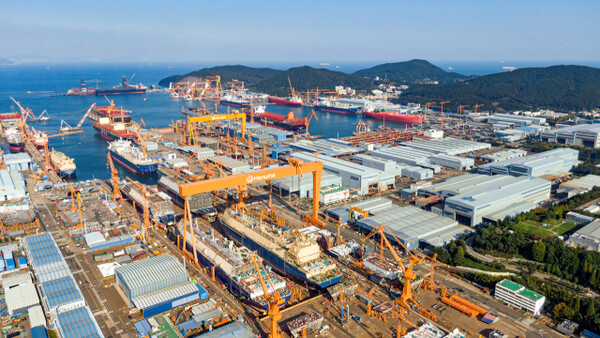Hanwha Ocean’s management and labor have reached an agreement on salary negotiations for 2025, laying the foundation for the smooth implementation of shipbuilding plans in the second half of the year. The agreement is seen as the beginning of a systematic reform of the overall salary structure in the Korean shipbuilding industry, namely the introduction of a salary system based on job difficulty and substantial salary increases guided by base wages.

Narrow the wage gap, increase basic wages, and improve the low wage structure in the shipbuilding industry
South Korean media reported that Hanwha Ocean’s labor and management sides have reached an agreement on the highest basic wage increase in history, which is expected to effectively solve the problem of low wages in South Korea’s shipbuilding industry as a whole.
As three of South Korea’s largest shipbuilders, HD Hyundai Heavy Industries, Samsung Heavy Industries, and Hanwha Ocean have long been perceived to have wage levels below the industry average. Compared to previous cases such as the general strike that followed the breakdown of wage negotiations at HD Hyundai Heavy Industries in 2015 and the union’s hardline stance during the restructuring of Daewoo Shipbuilding & Marine Engineering (now Hanwha Ocean) in 2017, the agreement reached between Hanwha Ocean’s management and labor this time is seen as a more “collaborative solution” and a “negotiation-based approach”.
A representative from the South Korean industry said, “With the current favorable global shipbuilding order situation, securing skilled labor and preventing talent loss has become an urgent task. The wage increase, which is mainly based on basic wages, is a forward-looking decision made to retain talent.”
The introduction of a wage system based on job difficulty marks the end of a decade of negotiations.
The core of Hanwha Ocean’s wage negotiations this time is the introduction of a compensation system based on job difficulty, which means moving away from a compensation model based solely on seniority and job title, and instead adopting a model based on “job difficulty” and “job importance.” This has been one of the core issues discussed by labor and management over the past decade, and a concrete framework was first established in 2025.
In the past, the South Korean shipbuilding industry has been criticized for failing to provide adequate compensation for jobs that require high-intensity work and technical proficiency. Since 2018, shipyards have experienced a steady loss of skilled labor due to a lack of young workers and an aging workforce. A compensation system based on the value of process responsibilities is expected to drive sustainable workforce transformation across the entire South Korean shipbuilding industry.
Approval rate of 61.7%, reaching a “forward-looking agreement” without labor-management disputes
It is reported that the agreement reached by Hanwha Ocean received 61.7% approval from union members, which is rare in the history of labor-management relations in the Korean shipbuilding industry, where disputes have been frequent. In particular, the fact that the negotiations were completed before the summer vacation helped to prevent shipbuilding interruptions and supply chain instability among partner companies in advance.
A representative from Hanwha Ocean stated, “These negotiations were the result of mutual respect and communication, and represent a joint effort by labor and management to enhance competitiveness in the global shipbuilding market. Going forward, we will continue to communicate and cooperate to build a foundation for sustainable growth.”
Hanwha Ocean’s agreement demonstrates the possibility of a shift from the past shipbuilding industry’s conflict-centered negotiation model to a trust-based collaborative model, which is worth noting. During the shipbuilding industry’s restructuring period in the early 2010s, repeated incidents such as long-term strikes, high-altitude protests, and reinstatement struggles led to operational uncertainty and a decline in external trust.
This agreement by Hanwha Ocean demonstrates that, through labor-management cooperation, mutual concessions, and coordination, it is possible to harmoniously achieve the dual goals of employment stability and enhanced corporate competitiveness. It is expected to have a direct or indirect impact on the negotiation processes of major shipbuilding companies such as Samsung Heavy Industries and HD Hyundai Heavy Industries, and may serve as an opportunity to drive discussions on innovation in the overall compensation system of South Korea’s shipbuilding industry.
Quarterly results announced, showing a significant turnaround from loss to profit year-on-year
In addition to reaching a historic labor agreement, Hanwha Ocean recently announced strong quarterly results.
In the second quarter of 2025, Hanwha Ocean achieved operating revenue of 3.29 trillion won (approximately US$2.349 billion), a year-on-year increase of 30%; and achieved operating profit of 371.7 billion won (approximately US$265 million), a significant turnaround from losses in the same period last year.
In the first half of 2025, Hanwha Ocean achieved operating revenue of 6.43 trillion won (approximately US$4.592 billion) and operating profit of 630.3 billion won (approximately US$450 million).
During the reporting period, Hanwha Ocean’s merchant ship division achieved growth in both operating revenue and profit; the special ship division’s operating revenue decreased slightly month-on-month, but still maintained a healthy profit margin thanks to submarine, surface ship and US Navy MRO projects; the offshore engineering division’s operating revenue increased slightly month-on-month, attributed to the nearing completion of the drillship performance improvement project.
Hanwha Ocean stated that the year-on-year increase in operating revenue was attributable to an increase in the number of days of shipyard operations and a rise in the proportion of high-margin liquefied natural gas (LNG) carrier sales. The turnaround from loss to profit was attributed to a decrease in the proportion of low-priced container ships in the production structure and a corresponding increase in LNG carrier business.


